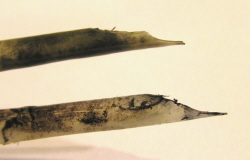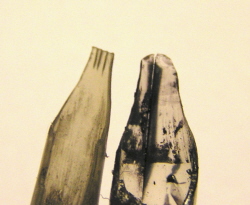Pitted against a metal nib, a quill almost always loses - strength, durability, convenience, level of skill required in user - metal nibs win. Metal pens have been around for an extraordinarily long time, since I think about 1000CE, but quills remained the writing instrument of choice for Europeans well into the nineteenth century, because they were so easily obtained and made.
Businesses bought quills by the thousand for their clerks, and professional quill-cutters were commonplace (a professional quill-cutter might reasonably be expected to produce between six and eight hundred pens per day). Metal nibs only took off with the advent of the steam-engine, mechanising the process so that mass-production of metal nibs became faster and cheaper than cutting feathers. It also took some time to develop a suitable alloy, one that was both flexible and durable. Once this was done, metal nibs quickly became ubiquitous, and the profession of quill-cutter obsolete.
Most pens, quill or otherwise, are shaped such that the barrel of the pen stays whole where the fingers grip it, but then is cut away and shaped into a nib (below, top). Torah scribes leave their nibs broad (below, bottom picture, left nib), so that they can make broad lines, but they may be larger or smaller, and for very fine writing the nib may be cut to a sharp point. As the pen is used, the corners tend to wear away (bottom picture, right nib) and the scribe will have to restore the shape every so often. Later on, we'll see that that can mean several times a day, so metal nibs are a good deal more convenient, for the most part.
However, a quill remains the tool of choice for top-flight calligraphers (har har), because it is capable of much more subtlety than any metal nib, more on that later. Soferim also have other issues with metal nibs; more on that later.


(You noticed, of course, that the left nib in the bottom picture has three ink channels instead of one. That's a modification one makes in certain circumstances, mostly in repair work when you are re-inking crumbling letters; you want a lot of ink and a lot of flexibility.)




No comments:
Post a Comment